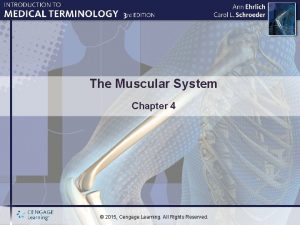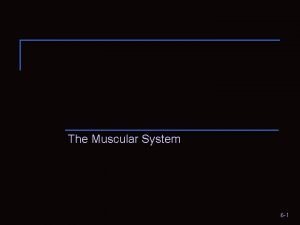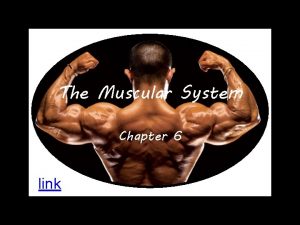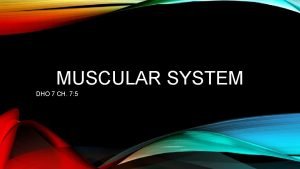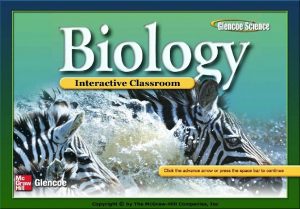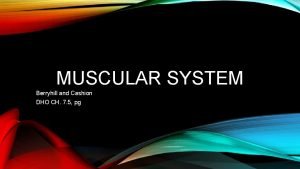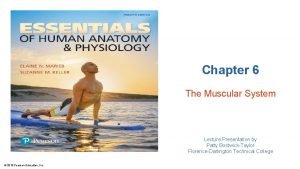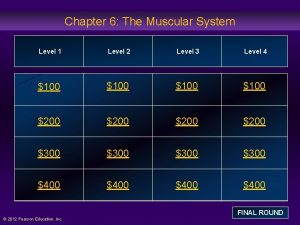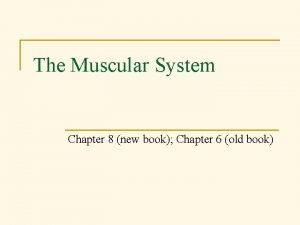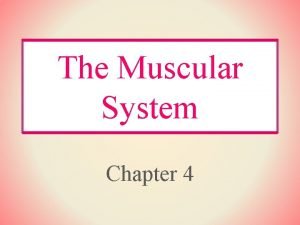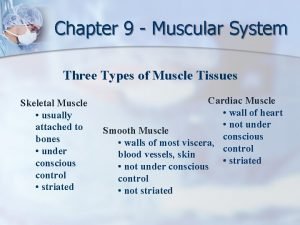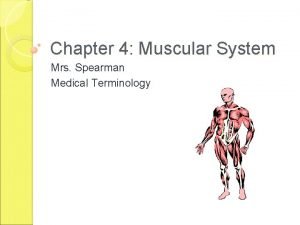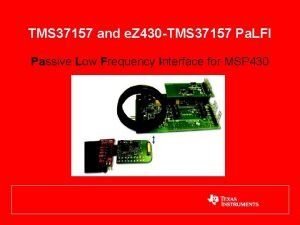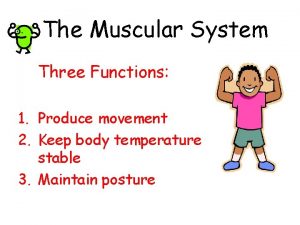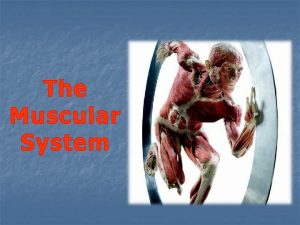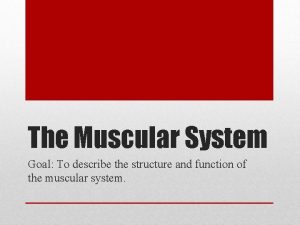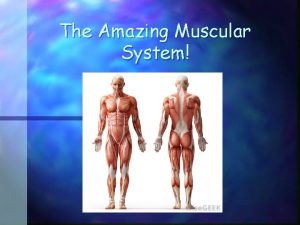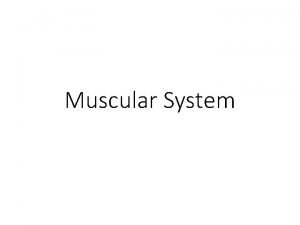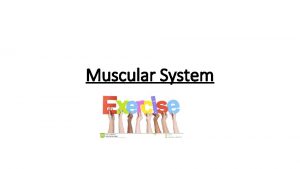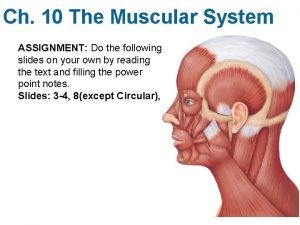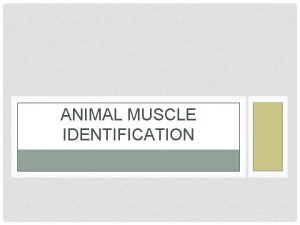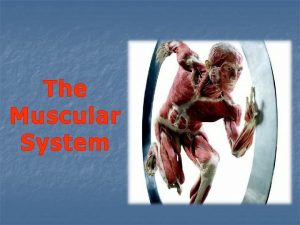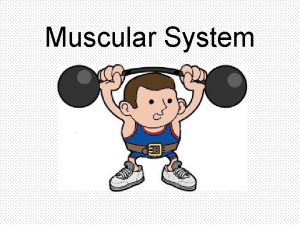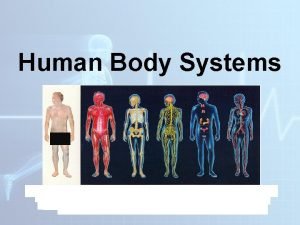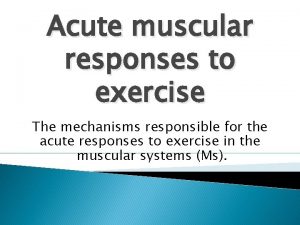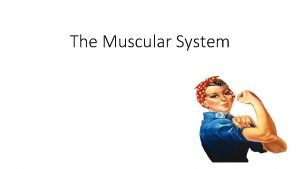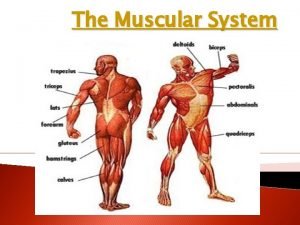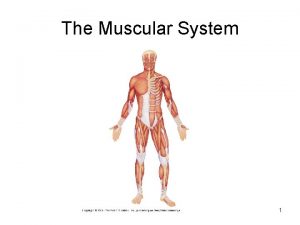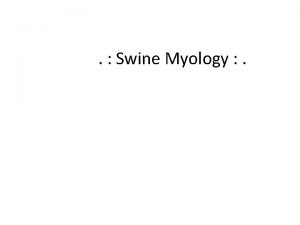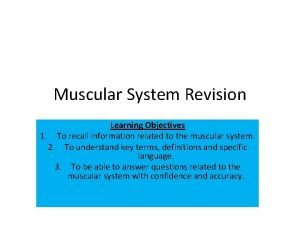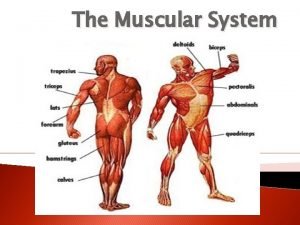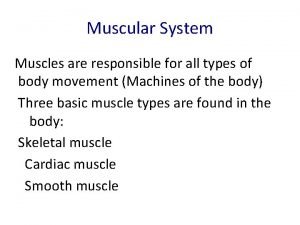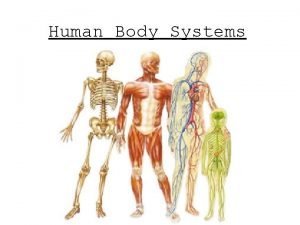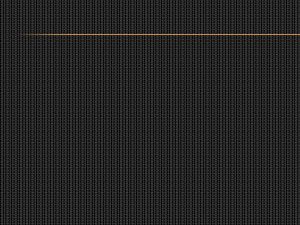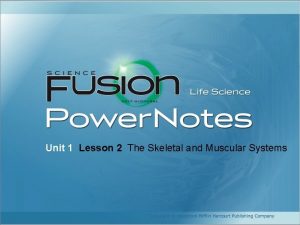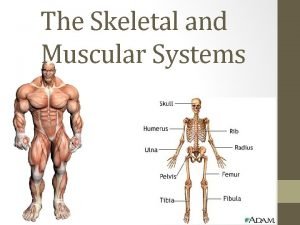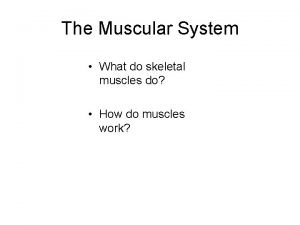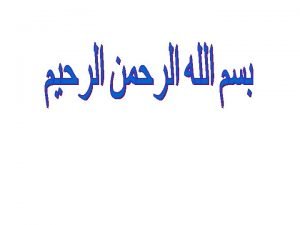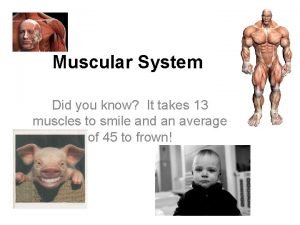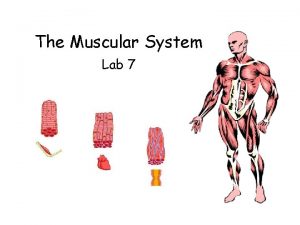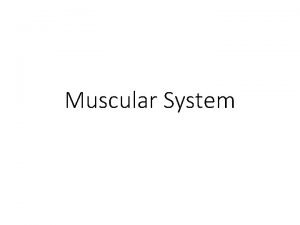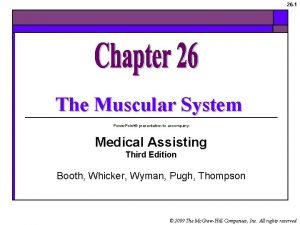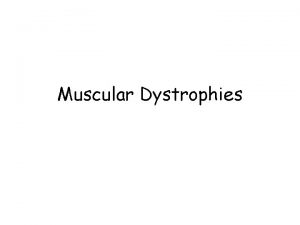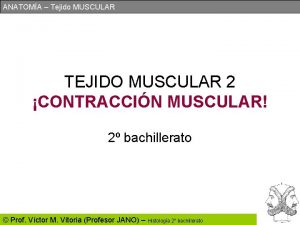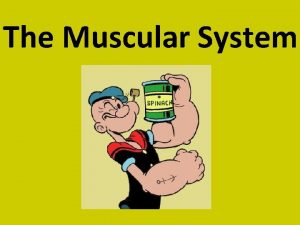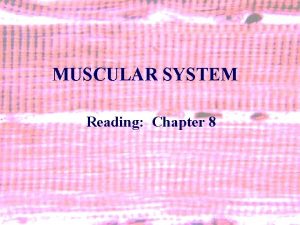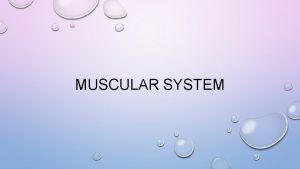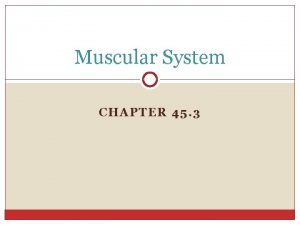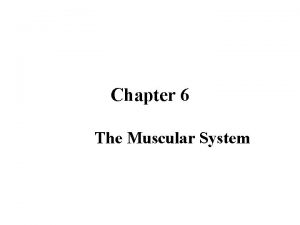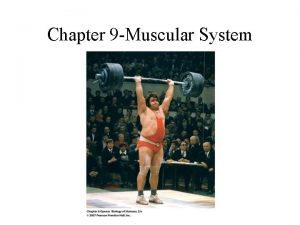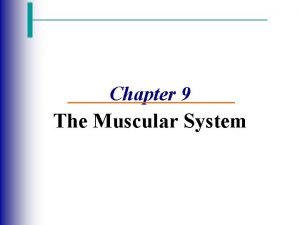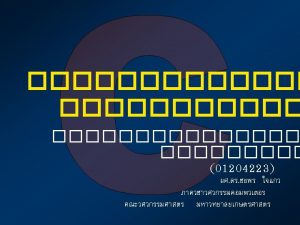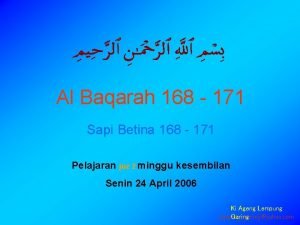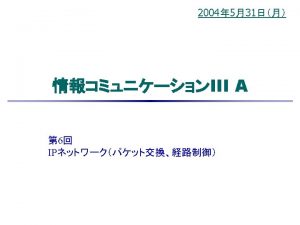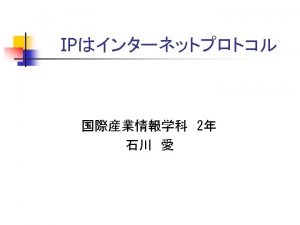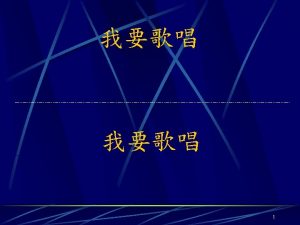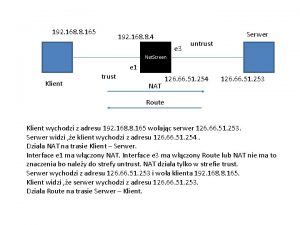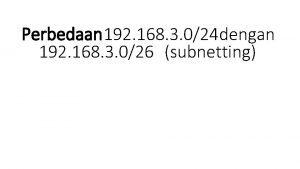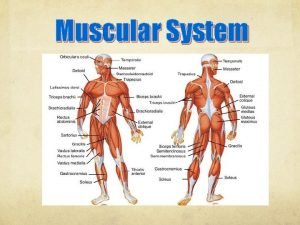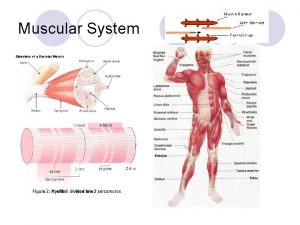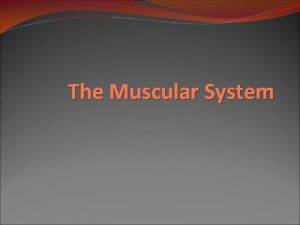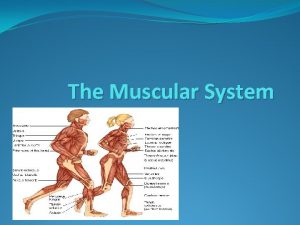The Muscular System Chapter 8 Read Page 168


































































- Slides: 66

The Muscular System Chapter 8

Read Page 168

8. 1 Introduction n n Muscle – an organ composed of specialized cells that uses chemical energy stored in nutrients to contract Functions ¨ movement ¨ muscle tone ¨ propel body fluids and ¨ generate heartbeat ¨ distribute heat n Types ¨ skeletal ¨ smooth ¨ cardiac food

8. 2 Structure of a Skeletal Muscle n Fascia ¨ layer of fibrous connective tissue ¨ separates muscles & holds in position ¨ projects beyond muscle to form tendon n n attaches to periosteum of bone Aponeuroses ¨ broad fibrous sheet ¨ attaches to bone or coverings of other muscles

8. 2 Structure of a Skeletal Muscle n Epimysium ¨ layer of connective tissue most closely surrounding muscle n Perimysium ¨ connective tissue extending inward from epimysium to separate the muscle tissue into smaller compartments n Fasicles ¨ compartments muscle fibers containing bundles of skeletal


8. 2 Structure of a Skeletal Muscle n Skeletal Muscle Fiber ¨ single cell ¨ contracts in response to stimulation ¨ Contains: Sarcolemma = cell membrane n Sarcoplasm = cytoplasm n nuclei n mitochondria n myofibrils = parallel threads n


8. 2 Structure of a Skeletal Muscle n Myofibrils ¨ Contain two types of protein filaments causes striations in muscle fiber Myosin – thick n Actin - thin n

I bands – light, thin actin filaments, connect to Z line A bands – dark, thick myosin overlaps thin actin H zone – thick filaments only M line – proteins holding thick filaments in place Sarcomere – area from Z line to Z line

Sarcoplasmic reticulum – membranous channels surrounding myofibril, run parallel T tubules – channels extending inward, passes all the way through Cisternae – enlarged portion of sarcoplasmic reticulum These areas activate muscle contration

Life Connection n Muscle strain ¨ tearing tissues ¨ Mild of muscle fibers and connective few fibers torn n fascia intact n minimal loss of function n ¨ Severe n everything torn n function may be completely lost

Review Describe how connective tissue is a part of a skeletal muscle. n Describe the general structure of a skeletal muscle fiber. n Explain why skeletal muscles appear striated. n Explain the relationship between the sarcoplasmic reticulum and transverse tubules. n

8. 2 Structure of a Skeletal Muscle n Neuromuscular Junction ¨ connection of motor neuron and muscle fiber

8. 2 Structure of a Skeletal Muscle n Motor End Plate ¨ specialized part of muscle fiber ¨ abundant mitochondria and nuclei ¨ sarcolemma folded n Neurotransmitters ¨ chemical excreted by axon ¨ stimulates muscle contraction Muscle fiber has single motor end plate but axons are densely branched n Motor Unit n ¨ motor neuron and fibers it controls

Review Which two structures approach each other at a neuromuscular junction? n Describe a motor end plate. n What is the function of a neurotransmitter? n What is a motor unit? n

8. 3 Skeletal Muscle Contraction Myosin molecule – two twisted protein strands with cross bridges Myosin filament – many molecules put together Actin molecule – contains binding site for cross bridges Actin filament – many molecules twisted into double helix containing troponin and tropomyosin

Sliding Filament Theory 1 & 2 – Calcium ion concentration rises, binding sites on actin filaments open, cross bridges attach

Sliding Filament Theory 3 & 4 – Upon binding to actin, cross bridges spring from the cocked position and pull on actin filament

Sliding Filament Theory 5. ATP binds to cross bridge causing it to release from the actin filament. 6. ATP breakdown provides energy to cock the unattached myosin cross bridge. Cycle continues as long as ATP and calcium are present.


8. 3 Skeletal Muscle Contraction n n Neurotransmitter = Acetylcholine Nerve impulse causes release into synaptic cleft Binds to receptors in muscle fibers Stimulates muscle impulse Impulse travels through T-tubules Reaches sarcoplasmic reticulum Calcium ions diffuse into sarcoplasm Troponin and Tropomyosin expose binding sites on actin Actin and myosin filaments link Muscle fiber contracts

When a skeletal muscle contracts the individual sarcomeres shorten as thick and thin filaments slide past one another.

8. 3 Skeletal Muscle Relaxation n n n Nerve impulses stop Acetylcholine broken down by acetylcholinesterase Calcium transported back into sarcoplasmic reticulum Links between actin and myosin break Troponin and Tropomyosin block binding sites on action Muscle fiber relaxes

Real World n Bacteria Clostridium botulinum ¨ Prevents release of acetylcholine ¨ Muscle fibers aren’t stimulated – paralyzed n bad if you’re trying to breathe ¨ “Botox” injections used to smooth wrinkles by preventing local muscles from contracting

8. 3 Energy Sources n n ATP only lasts short time – have to make more from ADP and Phosphate Creatine Phosphate – molecule with high energy phosphate bonds ¨ more abundant than ATP in muscle fibers ¨ stores excess energy from mitochondria ¨ when ATP low this excess energy is transferred to ADP molecules to make more ATP n Cellular respiration of glucose used when other sources depleted

8. 3 Oxygen Supply n n Needed to breakdown glucose in mitochondria Blood carries oxygen from lungs to body cells During rest or moderate activity respiratory and cardiovascular systems have no trouble supplying oxygen. Aerobic respiration-glucose broken into CO 2 and O 2

8. 3 Oxygen Debt n n n n Anaerobic Respiration Glucose broken down into pyruvic acid Pyruvic acid then produces lactic acid Lactic acid gets into bloodstream and is taken to the liver Liver uses ATP to make glucose out of the lactic acid During exercise not enough oxygen for liver to make glucose Debt = amount of oxygen needed for liver to make glucose + amount muscles need to restore ATP and creatine phosphate to their original concentrations

8. 3 Oxygen Debt Repayment may take several hours n Can change metabolism with training n ¨ increase amount of glycolytic enzymes ¨ more capillaries and mitochondria form

8. 3 Muscle Fatigue – loss of ability to contract n Can be caused by interruption of blood supply of lack of acetylcholine n Usually caused by too much lactic acid n ¨ lowers n p. H and fibers can’t contract Cramp – sustained involuntary contraction

Real Life n Rigor Mortis ¨ Calcium ions easily diffuse into membrane ¨ Decrease in ATP prevents relaxation ¨ Actin and Myosin stay linked until muscles start to decompose

8. 3 Heat Production ½ of body’s energy used for metabolic purposes n ½ becomes heat n All cells generate heat, but muscle is big part of body mass n Blood takes heat generated in muscles to other parts of body to maintain temperature n

Review Which biochemicals provide the energy to regenerate ATP? n What are the sources of oxygen for aerobic respiration? n How are lactic acid, oxygen debt, and muscle fatigue related? n What is the relationship between cellular respiration and heat production? n

8. 4 Muscular Responses n Threshold Stimulus ¨ minimal strength required to cause a contraction n All-or-None Response ¨ fibers don’t partly contract ¨ either it contracts all the way or not at all

8. 4 Recording Contractions n Twitch ¨ single n contraction Latent Period ¨ delay time between stimulus and response Myogram

Real World n Normal people ¨½ n fast twitch and ½ slow twitch Olympic sprinter ¨ 80% fast twitch n muscles bigger n stronger contractions n Olympic marathoner ¨ 90% slow twitch n resists fatigue n abundant mitochondria (aerobic)

Individual Twitches Summation muscle not completely relaxed before next stimulus arrives Tetanic Contraction – Tetanus – sustained contraction with no relaxation

8. 4 Muscular Responses n Recruitment ¨ Increase in the number of motor units being n low stimulus = few motor neurons stimulated n high stimulus = many neurons stimulated n n activated Summation and Recruitment produce sustained contractions of increasing strength Muscle Tone ¨ response to nerve impulses that stimulate a few muscle fibers ¨ needed to keep us from collapsing – like when we lose consciousness

Review Define threshold stimulus. n What is an all-or-none response? n Distinguish between a twitch and a sustained contraction. n How is muscle tone maintained? n

8. 5 Smooth Muscle n Not striated ¨ contains actin and myosin filaments, but they aren’t well organized ¨ sarcoplasmic reticulum not developed

8. 5 Smooth Muscle n Two types ¨ Multiunit n muscle fibers separate n irises of eyes and walls of blood vessels n contract only in response to stimulation by motor nerve impulses or hormones ¨ Visceral n sheets of cells in close contact with each other n walls of hollow organs (stomach, intestines, etc. ) n stimulate each other n rhythmicity – pattern of repeated contractions n Peristalsis – forces the content of the organs along their lengths

8. 5 Smooth Muscle Contraction n Like skeletal ¨ include actin and myosin ¨ triggered by membrane impulses and increased calcium concentration ¨ use ATP n Different from skeletal ¨ Neurotransmitters – acetylcholine and norepinephrine stimulate contractions in some muscles and inhibit in others ¨ affected by hormones ¨ slower to contract and relax ¨ maintain forceful contractions longer ¨ fibers can change length without changing tautness n stomach can fill up without losing pressure

Review Describe two major types of smooth muscle. n What special characteristics of visceral smooth muscle make peristalsis possible? n How does smooth muscle contraction differ from that of skeletal muscle? n

8. 6 Cardiac Muscle n n Only found in heart Composed of ¨ branching striated cells ¨ sarcoplasmic reticulum ¨ many mitochondria ¨ large transverse tubules ¨ cisternae not well developed ¨ intercalated discs n n n crossbands connecting opposing ends of cardiac cells helps impulses pass quickly Cells contract as unit ¨ Self-exciting and rhythmic

Review How is cardiac muscle similar to smooth muscle? n How is cardiac muscle similar to skeletal muscle? n What is the function of intercalated discs? n What characteristic of cardiac muscle contracts the heart as a unit? n

Origin – The immovable end of the muscle Insertion – The movable end of the muscle When a muscle contracts the insertion is pulled toward its origin

8. 7 Interaction of Skeletal Muscles n n Muscles usually function in groups Prime mover = Agonist ¨ The muscle doing the main work ¨ Deltoid lifts arm horizontally n Synergist ¨ Muscles that contract to assist the prime mover ¨ Makes prime mover’s actions more effective ¨ Hold shoulder steady n Antagonist ¨ Resist prime mover’s action and cause movement in opposite direction ¨ Lowers the arm

Review Distinguish between the origin and the insertion of a muscle. n Define prime mover. n What is the function of a synergist? An antagonist? n

FYI n n Human body contains over 600 muscles Face has 60 ¨ 40 used to frown ¨ 20 to smile n Smallest ¨ stapedius n Largest ¨ gluteus n – middle ear maximus Longest ¨ sartorius

















 Plyometrics disadvantages
Plyometrics disadvantages Chapter 4 the muscular system
Chapter 4 the muscular system Muscular system figure
Muscular system figure Chapter 6 the muscular system
Chapter 6 the muscular system Chapter 6 the muscular system figure 6-9
Chapter 6 the muscular system figure 6-9 7:5 muscular system
7:5 muscular system Aerobic respiration exercise
Aerobic respiration exercise Chapter 32 section 3 the muscular system answer key
Chapter 32 section 3 the muscular system answer key Chapter 6 the muscular system figure 6-9
Chapter 6 the muscular system figure 6-9 Chapter 7:5 muscular system
Chapter 7:5 muscular system Chapter 6 the muscular system
Chapter 6 the muscular system Cengage chapter 4 answers
Cengage chapter 4 answers Chapter 6 the muscular system
Chapter 6 the muscular system Chapter 6 the muscular system
Chapter 6 the muscular system Chapter 10 the muscular system
Chapter 10 the muscular system Chapter 8 the muscular system
Chapter 8 the muscular system The muscular system chapter 4
The muscular system chapter 4 Chapter 9 muscular system
Chapter 9 muscular system Define myocele
Define myocele Apa title format
Apa title format Read this page
Read this page Getezone
Getezone How do muscles move
How do muscles move Muscular system
Muscular system Mascular system function
Mascular system function Amazing facts about the muscular system
Amazing facts about the muscular system Epi peri and endomysium
Epi peri and endomysium Muscular system label
Muscular system label Muscular system head and neck
Muscular system head and neck Brachiocephalicus
Brachiocephalicus Navigating the body skeletal system #2
Navigating the body skeletal system #2 Whats the function of the muscular system
Whats the function of the muscular system Whats the purpose of the muscular system
Whats the purpose of the muscular system Sarcomore
Sarcomore Muscular system response to exercise
Muscular system response to exercise Whats the muscular system
Whats the muscular system Human body muscles name
Human body muscles name Muscular system
Muscular system Superficial muscular system
Superficial muscular system Anatomy of a pig
Anatomy of a pig Muscular system learning objectives
Muscular system learning objectives What are the major functions of the muscular system
What are the major functions of the muscular system Muscular system means
Muscular system means 3 function of muscular system
3 function of muscular system Muscular system
Muscular system Lesson outline lesson 2 the muscular system answer key
Lesson outline lesson 2 the muscular system answer key The muscular system
The muscular system Skeletal and muscular system
Skeletal and muscular system Named
Named Major muscles
Major muscles Muscular system diagram
Muscular system diagram Muscle diagram
Muscle diagram Whats the job of the muscular system
Whats the job of the muscular system Lab 7 the muscular system
Lab 7 the muscular system Muscular root word
Muscular root word Skeletal and muscular system
Skeletal and muscular system Muscular system
Muscular system Chapter 36 skeletal muscular and integumentary systems
Chapter 36 skeletal muscular and integumentary systems Chapter 14 skeletal muscular and nervous systems
Chapter 14 skeletal muscular and nervous systems Hát kết hợp bộ gõ cơ thể
Hát kết hợp bộ gõ cơ thể Lp html
Lp html Bổ thể
Bổ thể Tỉ lệ cơ thể trẻ em
Tỉ lệ cơ thể trẻ em Gấu đi như thế nào
Gấu đi như thế nào Chụp tư thế worms-breton
Chụp tư thế worms-breton Chúa yêu trần thế
Chúa yêu trần thế Môn thể thao bắt đầu bằng từ chạy
Môn thể thao bắt đầu bằng từ chạy

